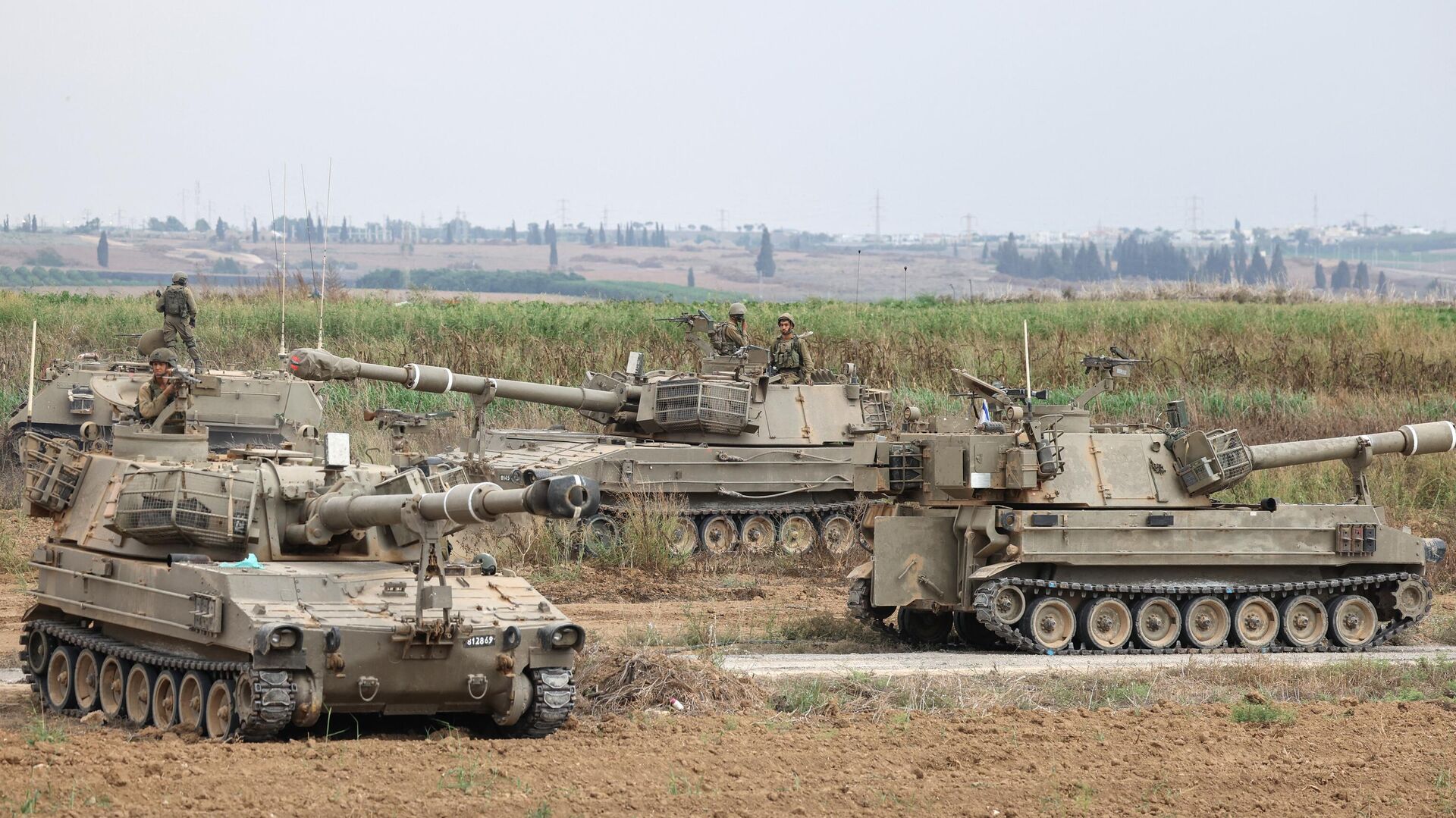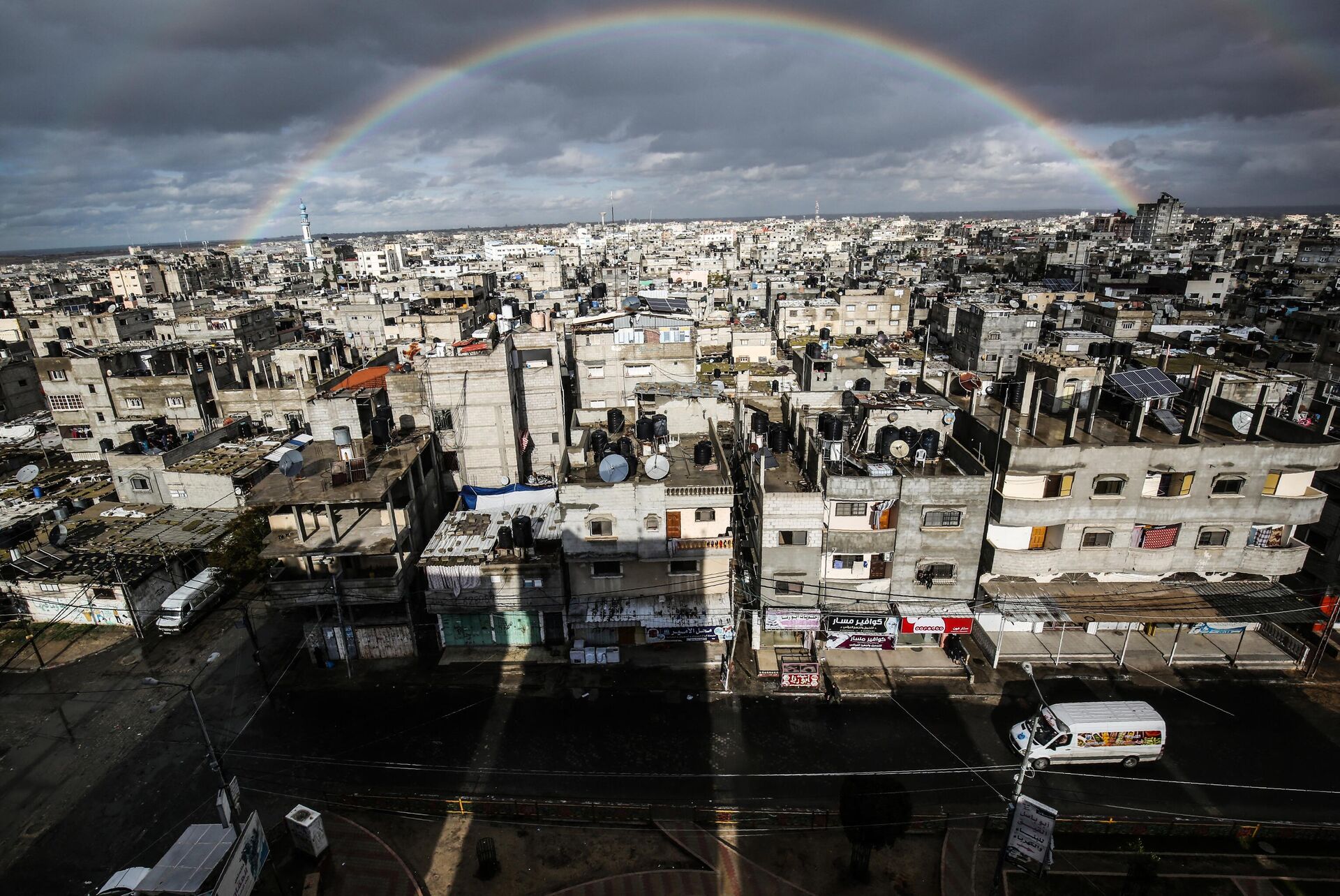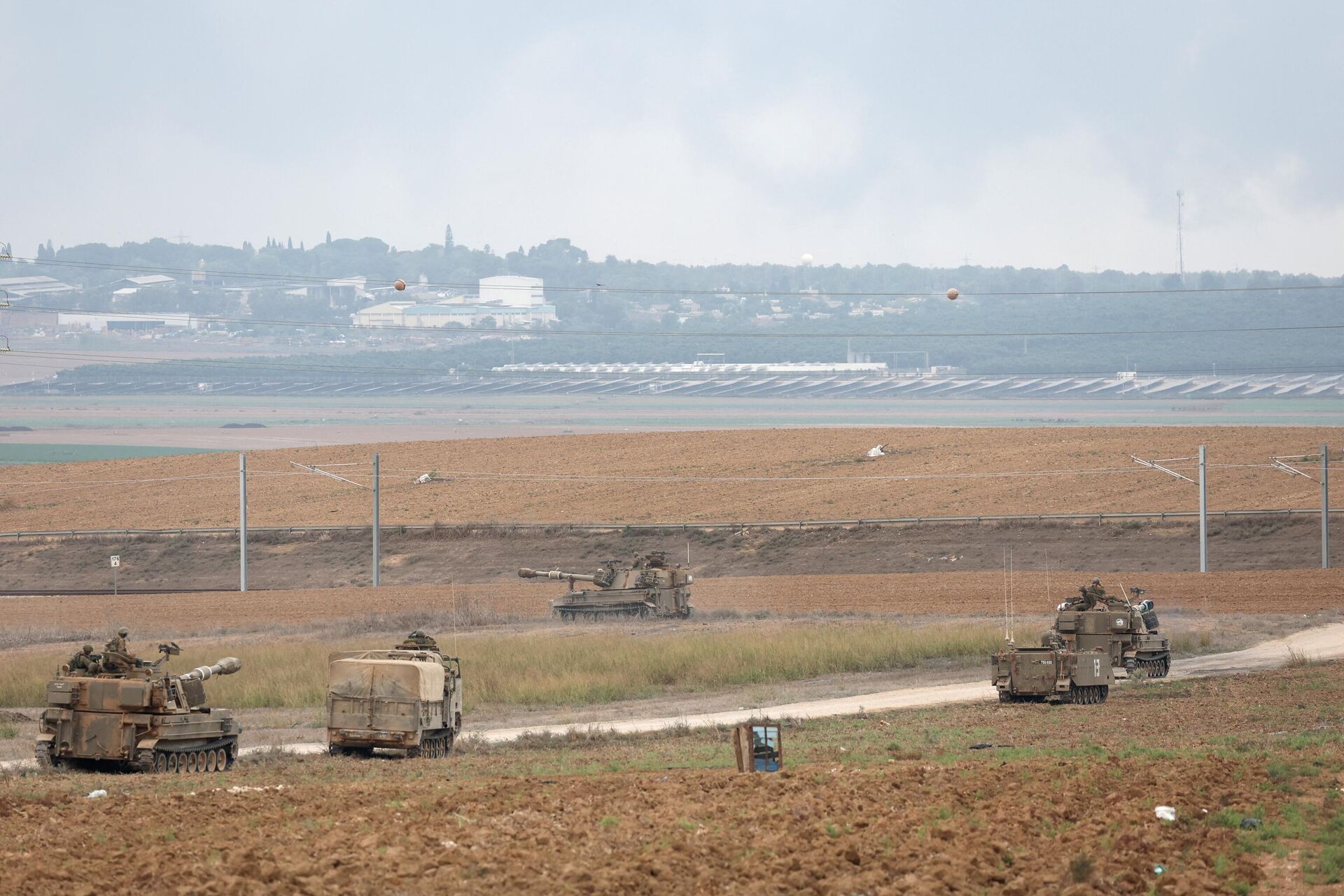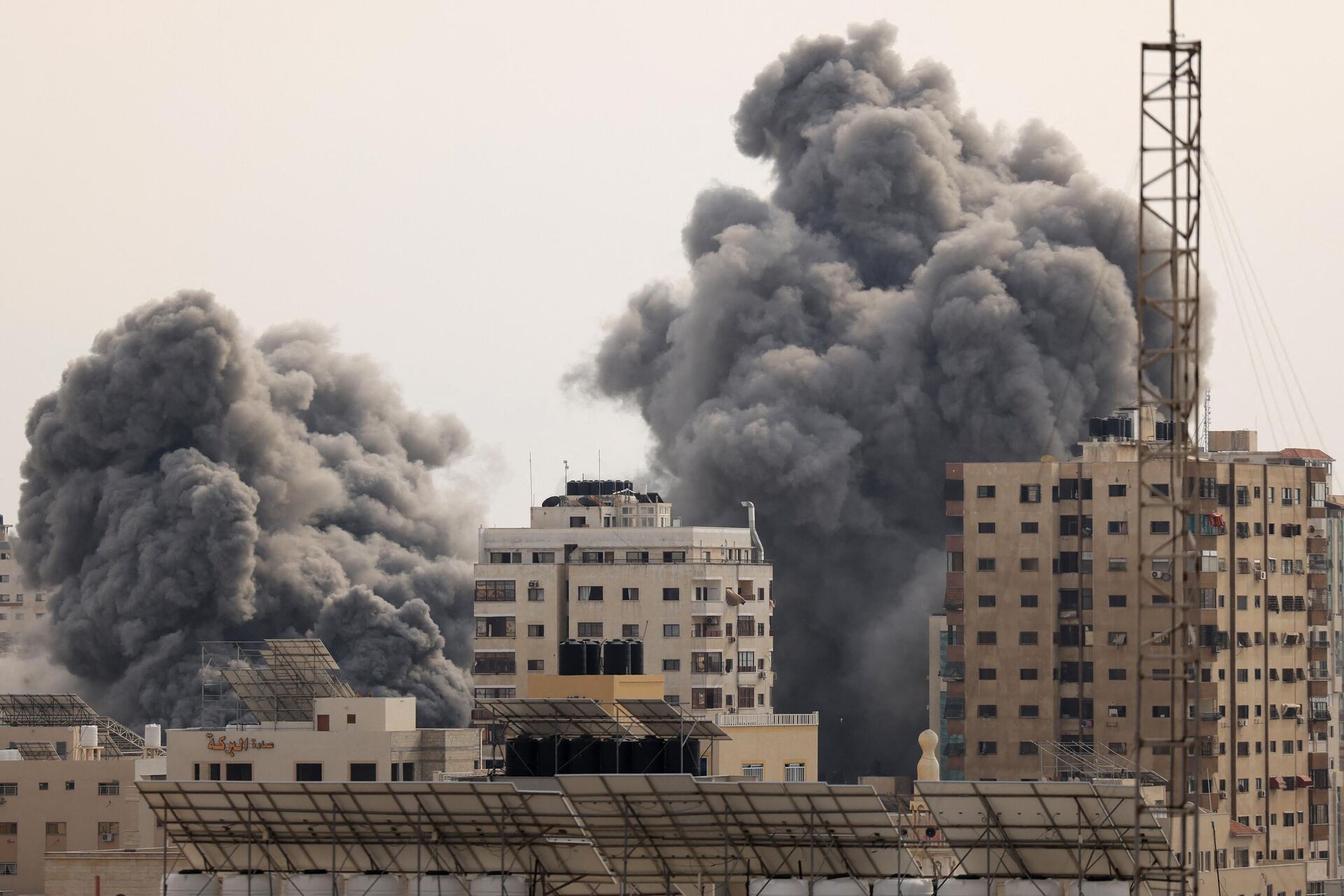https://sputnikglobe.com/20231010/what-is-the-gaza-strip-now-under-israels-complete-siege-1114041855.html
What is the Gaza Strip Now Under Israel’s Complete Siege?
What is the Gaza Strip Now Under Israel’s Complete Siege?
Sputnik International
Israel has ordered a total blockade of the Gaza Strip to leave it with no electricity, food and fuel. Where is Gaza located and who now controls it? Sputnik answers these and other questions.
2023-10-10T11:18+0000
2023-10-10T11:18+0000
2023-10-10T11:18+0000
world
israel
palestinian authority
gaza strip
armed conflict
border
palestine-israel conflict
https://cdn1.img.sputnikglobe.com/img/07e7/0a/09/1114041504_0:161:3071:1888_1920x0_80_0_0_74b2abb01d76c968b27034c110322104.jpg
What is the Gaza Strip and Why is it Important?The Gaza Strip, also known as Gaza, is a Palestinian exclave located on the eastern coast of the Mediterranean Sea, an area that along with the West Bank makes up the Palestinian National Authority (PA or PNA), which has been under Israel’s control since 1967.Nestled between Israel, Egypt and the Mediterranean, the exclave has an area of about ten kilometers (six miles) wide and 41 kilometers (25 miles) long. It is believed to be one of the most densely populated areas in the world. According to information from open sources, Gaza’s population (before the current Hamas-Israel armed conflict) was more than two million people, which means an average of about 5,500 people per square kilometer.Still, the Gaza population is almost sure to shrink due to the October 7 Hamas attack on Israel, which retaliated by starting to launch strikes on Gaza in which over 700 have already died.Why it is Called Gaza StripThe area was named after its densely-populated capital of Gaza City.Jews, Lebanese, Palestinians, and Syrians are the modern descendants of the Canaanites, who were wiped out by the Israelites, according to Bible accounts.What's the Gist of Israel's Gaza-Related Claims According to the 1947 UN Plan for the division of Palestine into Arab and Jewish states, the Gaza Strip was seen as part of the territory to establish an Arab state.The plan was accepted by Israel but rejected by members of the Arab League, including Egypt, which started military action resulting in the 1948 Arab–Israeli War. During the war, Israel gained additional territories that were designated to be part of the Arab state under the UN plan. Egypt occupied the Gaza Strip in 1948, initially supporting the creation of an All-Palestine Government, which was disbanded in 1959. The 1967 so-called Six-Day War resulted in Gaza coming under Israel’s control. The area was controlled by Israel between 1967 and 2005.During the implementation of the Unilateral Disengagement Plan in August 2005, Israel withdrew its troops from Gaza and dismantled its settlements there.As a result of the coup carried out by the Islamist militant group Hamas in July 2007, the government institutions of the PA and the Gaza Strip came under the group’s authority. In October 2007, Israel declared Gaza a “hostile state” and began a partial economic blockade of the area, occasionally cutting off electricity and water supplies there.Who Currently Lives in the Strip?Those residing in Gaza are Palestinians, who include both the people who were original residents there and numerous refugees who fled to the area from Israel after the founding of the Jewish state in 1948 and the subsequent military conflicts between Israelis and Palestinians.Most of the residents live in the north of the area, in particular in Gaza City. Sunni Muslims make up the predominant part of the population but there is also a Palestinian Christian minority. Nearly 40% of the population is under the age of 15.Who Gave Gaza Strip to PA?Gaza remained part of the Ottoman Empire before 1918, and subsequent years saw the Gaza Strip occupied by Britain and Egypt. In 1967, Israel took control of Gaza and 27 years later, Tel Aviv granted the PA in Gaza limited self-governance through the Oslo Accords, an array of peace deals signed by Israel and the Palestine Liberation Organization in Washington in 1993.The Palestinian government then unsuccessfully tried to negotiate Israeli troop withdrawals with Tel Aviv, an issue that was finally tackled by then-Israeli Prime Minister Ariel Sharon in late 2003. In September 2005, Israel wrapped up the withdrawal of its troops from Gaza, and control of the area was transferred to the PA. The Israel Defense Forces (IDF), however, continued to patrol Gaza borders and airspace at the time.Who Currently Governs Gaza?Since 2007, the Gaza Strip has been governed by the militant group Hamas, which rejects the peace process with Israel. In its charter, Hamas specifically calls for the destruction of the Jewish state that blacklists the group as a terrorist organization.Hamas fighters have launched rockets from Gaza toward Israeli areas for years, but this past Saturday saw an unprecedented escalation of the simmering conflict, in which scores of Hamas fighters infiltrated the Jewish state by land, sea and air.Does Israel Continue to Control Gaza?The UN, along with international human rights organizations and many governments, still consider Gaza to be occupied by Israel despite the Jewish state’s disengagement from the area in 2005. Israel actually continues to maintain direct external control over Gaza and indirect control over life within the territory.In particular, Tel Aviv controls Gaza's air and maritime space and six of the area’s seven land crossings. Israel also reserves the right to enter Gaza at will using its military and it maintains a no-go buffer zone within the Gaza soil. On top of that, Gaza is dependent on Israel for its water, electricity, telecommunications, and other utilities.Can Palestinians Leave Gaza?The Jewish state imposed restrictions on the movement of Palestinians within the West Bank, and travel between it and the Gaza Strip, as well as into East Jerusalem, Israel, and abroad. In contrast, Israelis, as well as Jewish settlers and foreigners are not subject to the above-mentioned restrictions and are free to travel in and out of Gaza.According to the outlet, “these conditions result in a life of constant uncertainty for Palestinians, making it difficult to perform simple tasks and plan their lives,” something that also “obstructs the development of a stable economy.”The outlet added that Israel bans Palestinians from entering or leaving the area “except in extremely rare cases, which include urgent, life-threatening medical conditions and a very short list of merchants.”US Watchdog HRW, in turn, has slammed living conditions in Gaza as “an open air prison,” referencing the restriction of movement that Israel enforces on Palestinians there.“The Gaza closure blocks talented, professional people, with much to give their society, from pursuing opportunities that people elsewhere take for granted. Barring Palestinians in Gaza from moving freely within their homeland stunts lives and underscores the cruel reality of apartheid and persecution for millions of Palestinians,” the group said in a report.Conditions for Gaza civilians are expected to worsen dramatically in the wake of the October 7 Hamas attack. Earlier on Monday, Israel’s Defense Minister Yoav Gallant announced “a complete siege” of Gaza, cutting off all electricity, fuel, food and water to the enclave.How Did Curent Hamas-Israel Conflict Develop? The current Hamas-Israel armed conflict started with an unprecedented attack by the militant group on October 7, when Hamas reportedly launched several thousands of rockets towards Israel.The attack was conducted in coordination with several other militant groups, including the Palestinian Islamic Jihad and the Popular Front for the Liberation of Palestine.Israeli Defense Minister Yoav Gallant, for his part, said that he has ordered a “complete siege” of Gaza, which stipulates halting the supply of electricity, food, water and fuel to the Palestinian enclave.He spoke as the IDF continued to pound the area with airstrikes to hit the targets which included several towers that purportedly were used by Hamas and “a number of terrorist squads in the area surrounding the Gaza Strip.”The airstrikes came amid reports about Hamas holding more than 100 hostages, including Israeli army officers. The group reportedly pledged said that the hostages would be executed without warning if Israel continues to targets people in Gaza, where more than 137,000 people took cover from Israeli strikes at UN emergency shelters.
israel
gaza strip
Sputnik International
feedback@sputniknews.com
+74956456601
MIA „Rossiya Segodnya“
2023
Oleg Burunov
https://cdn1.img.sputnikglobe.com/img/07e4/09/0b/1080424846_0:0:2048:2048_100x100_80_0_0_3d7b461f8a98586fa3fe739930816aea.jpg
Oleg Burunov
https://cdn1.img.sputnikglobe.com/img/07e4/09/0b/1080424846_0:0:2048:2048_100x100_80_0_0_3d7b461f8a98586fa3fe739930816aea.jpg
News
en_EN
Sputnik International
feedback@sputniknews.com
+74956456601
MIA „Rossiya Segodnya“
Sputnik International
feedback@sputniknews.com
+74956456601
MIA „Rossiya Segodnya“
Oleg Burunov
https://cdn1.img.sputnikglobe.com/img/07e4/09/0b/1080424846_0:0:2048:2048_100x100_80_0_0_3d7b461f8a98586fa3fe739930816aea.jpg
israel-hamas armed conflict, israel's complete siege of gaza strip, hamas attack on israel, israel;s restrictions on palestinians' movement in gaza
israel-hamas armed conflict, israel's complete siege of gaza strip, hamas attack on israel, israel;s restrictions on palestinians' movement in gaza
What is the Gaza Strip Now Under Israel’s Complete Siege?
Israel has ordered a total blockade of the Gaza Strip to leave it with no electricity, food and fuel, in developments that come amid the ongoing armed conflict between Tel Aviv and Hamas. Where is Gaza located and who now controls it? Sputnik answers these and other questions.
What is the Gaza Strip and Why is it Important?
The Gaza Strip, also known as Gaza, is a Palestinian exclave located on the eastern coast of the Mediterranean Sea, an area that along with the West Bank makes up the Palestinian National Authority (PA or PNA), which has been under Israel’s control since 1967.
Nestled between Israel, Egypt and the Mediterranean, the exclave has an area of about ten kilometers (six miles) wide and 41 kilometers (25 miles) long. It is believed to be one of the most densely populated areas in the world. According to information from open sources, Gaza’s population (before the current Hamas-Israel armed conflict) was more than two million people, which means an average of about 5,500 people per square kilometer.
Still, the Gaza population is almost sure to shrink due to
the October 7 Hamas attack on Israel, which retaliated by starting to launch strikes on Gaza in which over 700 have already died.
Why it is Called Gaza Strip
The area was named after its densely-populated capital of Gaza City.
It were the Canaanites who most likely gave Gaza its name, which means “strength” in ancient Semitic languages. The Egyptians called the area “Gazzat” (prized city).
Jews, Lebanese, Palestinians, and Syrians are the modern descendants of the Canaanites, who were wiped out by the Israelites, according to Bible accounts.
What's the Gist of Israel's Gaza-Related Claims
According to the 1947 UN Plan for the division of Palestine into Arab and Jewish states, the Gaza Strip was seen as part of the territory to establish an Arab state.
The plan was accepted by Israel but rejected by members of the Arab League, including Egypt, which started military action resulting in the 1948 Arab–Israeli War. During the war, Israel gained additional territories that were designated to be part of the Arab state under the UN plan. Egypt occupied the Gaza Strip in 1948, initially supporting the creation of an All-Palestine Government, which was disbanded in 1959. The 1967 so-called Six-Day War resulted in Gaza coming under Israel’s control. The area was controlled by Israel between 1967 and 2005.
During the implementation of the Unilateral Disengagement Plan in August 2005, Israel withdrew its troops from Gaza and dismantled its settlements there.
As a result of the coup carried out by the Islamist militant group Hamas in July 2007, the government institutions of the PA and the Gaza Strip came under the group’s authority. In October 2007, Israel declared Gaza a “hostile state” and began a partial economic blockade of the area, occasionally cutting off electricity and water supplies there.
Who Currently Lives in the Strip?
Those residing in Gaza are Palestinians, who include both the people who were original residents there and numerous refugees who fled to the area from Israel after the founding of the Jewish state in 1948 and the subsequent military conflicts between Israelis and Palestinians.
Most of the residents live in the north of the area, in particular in Gaza City. Sunni Muslims make up the predominant part of the population but there is also a Palestinian Christian minority. Nearly 40% of the population is under the age of 15.
Who Gave Gaza Strip to PA?
Gaza remained part of the Ottoman Empire before 1918, and subsequent years saw the Gaza Strip occupied by Britain and Egypt. In 1967, Israel took control of Gaza and 27 years later, Tel Aviv granted the PA in Gaza limited self-governance through the Oslo Accords, an array of peace deals signed by Israel and the Palestine Liberation Organization in Washington in 1993.
The Palestinian government then unsuccessfully tried to negotiate Israeli troop withdrawals with Tel Aviv, an issue that was finally tackled by then-Israeli Prime Minister Ariel Sharon in late 2003. In September 2005, Israel wrapped up the withdrawal of its troops from Gaza, and control of the area was transferred to the PA. The Israel Defense Forces (IDF), however, continued to patrol Gaza borders and airspace at the time.
Who Currently Governs Gaza?
Since 2007, the Gaza Strip has been governed by the militant group Hamas, which rejects the peace process with Israel. In its charter, Hamas specifically calls for the destruction of the Jewish state that blacklists the group as a terrorist organization.
Hamas fighters have launched rockets from Gaza toward Israeli areas for years, but this past Saturday saw an unprecedented
escalation of the simmering conflict, in which scores of Hamas fighters infiltrated the Jewish state by land, sea and air.
Does Israel Continue to Control Gaza?
The UN, along with international human rights organizations and many governments, still consider Gaza to be occupied by Israel despite the Jewish state’s disengagement from the area in 2005. Israel actually continues to maintain direct external control over Gaza and indirect control over life within the territory.
In particular, Tel Aviv controls Gaza's air and maritime space and six of the area’s seven land crossings. Israel also reserves the right to enter Gaza at will using its military and it maintains a no-go buffer zone within the Gaza soil. On top of that, Gaza is dependent on Israel for its water, electricity, telecommunications, and other utilities.
Can Palestinians Leave Gaza?
The Jewish state imposed restrictions on the movement of Palestinians within the West Bank, and travel between it and the Gaza Strip, as well as into East Jerusalem, Israel, and abroad. In contrast, Israelis, as well as Jewish settlers and foreigners are not subject to the above-mentioned restrictions and are free to travel in and out of Gaza.
An Israeli human rights news outlet reported in this vein that “when travel permits are required by Israel, they are given [to Palestinians] through a lengthy, non-transparent and arbitrary bureaucratic process.”
According to the outlet, “these conditions result in a life of constant uncertainty for Palestinians, making it difficult to perform simple tasks and plan their lives,” something that also “obstructs the development of a stable economy.”
The outlet added that Israel bans Palestinians from entering or leaving the area “except in extremely rare cases, which include urgent, life-threatening medical conditions and a very short list of merchants.”
US Watchdog HRW, in turn, has slammed living conditions in Gaza as “an open air prison,” referencing the restriction of movement that Israel enforces on Palestinians there.
“The Gaza closure blocks talented, professional people, with much to give their society, from pursuing opportunities that people elsewhere take for granted. Barring Palestinians in Gaza from moving freely within their homeland stunts lives and underscores the cruel reality of apartheid and persecution for millions of Palestinians,” the group said in a report.
Conditions for Gaza civilians are expected to worsen dramatically in the wake of
the October 7 Hamas attack. Earlier on Monday, Israel’s Defense Minister Yoav Gallant announced “a complete siege” of Gaza, cutting off all electricity, fuel, food and water to the enclave.
How Did Curent Hamas-Israel Conflict Develop?
The current Hamas-Israel armed conflict started with an unprecedented attack by the militant group on October 7, when Hamas reportedly launched several thousands of rockets towards Israel.
The attack was conducted in coordination with several other militant groups, including the Palestinian Islamic Jihad and the Popular Front for the Liberation of Palestine.
Israeli Prime Minister Benjamin Netanyahu responded by pledging that Hamas would pay the price and saying that Israel is currently at war. Shortly after, he said that Israel's “first phase” of its retaliation had ended with the “destruction of the majority of the enemy forces that penetrated our [Israeli] territory.”
Israeli Defense Minister Yoav Gallant, for his part, said that he has ordered a “complete siege” of Gaza, which stipulates halting the supply of electricity, food, water and fuel to the Palestinian enclave.
He spoke as the IDF continued to pound the area with airstrikes to hit the targets which included several towers that purportedly were used by Hamas and “a number of terrorist squads in the area surrounding the Gaza Strip.”
The airstrikes came amid reports about Hamas holding more than 100 hostages, including Israeli army officers. The group reportedly pledged said that the hostages would be executed without warning if Israel continues to targets people in Gaza, where more than 137,000 people took cover from Israeli strikes at UN emergency shelters.
The Mission of the State of Palestine to the UN meanwhile released a statement saying that “these developments did not occur in a vacuum, they are preceded by the killing this year of hundreds of Palestinians”.






